Rende
Rende is a city and comune in the province of Cosenza, Calabria, southern Italy, home to the headquarters of the University of Calabria. It has a population of about 35,000, or more than 60,000 if the university students living there are taken into account. It is divided in two parts: the old town, which is stands on a high hill, and the modern area, on level ground, which is connected to the city of Cosenza and with it is the centre of the economy of the province of Cosenza.
Rende | |
|---|---|
| Città di Rende | |
.jpg.webp) Via Rossini, the city center of Rende. | |
 Coat of arms | |
.svg.png.webp) Rende within the Province of Cosenza | |
Location of Rende 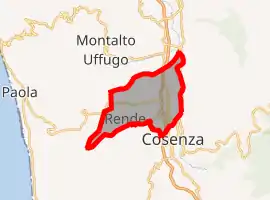 | |
 Rende Location of Rende in Italy 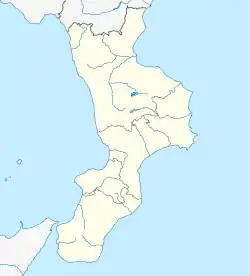 Rende Rende (Calabria) | |
| Coordinates: 39°20′N 16°11′E | |
| Country | Italy |
| Region | Calabria |
| Province | Cosenza (CS) |
| Frazioni | Arcavacata, Commenda, Quattromiglia, Roges, Santo Stefano, Saporito, Surdo |
| Government | |
| • Mayor | Marcello Manna (Lista Civica) |
| Area | |
| • Total | 54 km2 (21 sq mi) |
| Elevation | 480 m (1,570 ft) |
| Population (2004)[2] | |
| • Total | 35,221 |
| • Density | 650/km2 (1,700/sq mi) |
| Demonym | Rendesi |
| Time zone | UTC+1 (CET) |
| • Summer (DST) | UTC+2 (CEST) |
| Postal code | 87036 |
| Dialing code | 0984 |
| Patron saint | Immaculate Conception |
| Saint day | February 20 |
| Website | Official website |
Geography
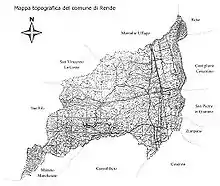
Rende stretches from the left river of the Crati to the mountains called "Serre Cosentine".
- Southern borders: Cosenza, Castrolibero, Marano Marchesato and Marano Principato.
- Northern borders: Montalto Uffugo and San Vincenzo La Costa.
- Western borders: San Fili.
- Eastern borders: Castiglione Cosentino, Rose, San Pietro in Guarano and Zumpano.[3]
The municipality counts the hamlets (frazioni) of Arcavacata, Commenda, Quattromiglia, Roges, Santo Stefano, Saporito and Surdo.
The territory presents mountain areas from west that degrade slowly eastward forming hills, one of which is the historic centre, until the valley of the Crati. Thanks to large flat areas, it is covered by the modern city. The most important rivers crossing Rende are Crati, Campagnano, Surdo and Emoli.
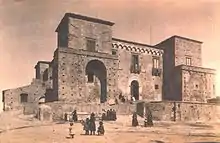
History
The Oenotrians founded here a town named Acheruntia and, later, Pandosia. However, several inhabitants later moved to a more defendable area, corresponding to the modern frazione of Nogiano, founding (c. 520 BC) the new settlement of Aruntia, later, Arintha. This is mentioned by the ancient Greek historian Hecataeus of Miletus as a Bruttian town of Oenotrian origins.
During Roman times, the town followed the history of the nearby Cosentia. After a long resistance, it was sacked by Totila's troops in 547, during the Gothic Wars. In the 8th-10th centuries, it was sometimes attacked by Saracen troops, until part of the population moved in what is now the territory of Castiglione Cosentino. Later it was controlled by the Normans and subsequently other southern Italian (sometimes of foreign origin) dynasties.
Main sights
- Norman Castle, built in 1095 by Bohemond I of Antioch.
- Mother church of Santa Maria Maggiore, built around 12th century but rebuilt several times, the last in the late 18th century
- Sanctuary of Maria Santissima di Costantinopoli
Economy
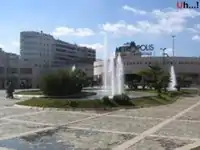
The economy of Rende is mostly based on the University of Calabria. In comparison to the rest of southern Italy, Rende has quite a strong economy and is therefore in full expansion. While full industrialization has not yet been very successful, in recent times, major companies have established offices in Rende. Among these are the Japanese Digital and Data Innovation company NTT Data,[4] which has a Research and Development office in Rende; and JRS Silvateam Food Ingredients.[5] Although Rende has an adequate industrial area, a lot of its area still needs to be developed.
Sports
Rende is home to the football team Rende Calcio, which competes in the official semi-professional tournament (C2)
Sources
- Fonte, Fedele (1976). Rende nella sua cronistoria (in Italian). Chiaravalle Centrale: Frama Sud.
- Miceli di Serradileo, Amedeo (2013). Il partito angioino a Cosenza e le sue vicende tra la guerra dei baroni di Ferrante I ed il regno di Carlo V attraverso i documenti dell'Archivio di Stato di Cosenza, in "Archivio Storico per le province napoletane (in Italian). Napoli: Società Napoletana di Storia Patria.
- Giraldi, Gerardo (1991). Rende: Usanze, tradizioni, costumi (in Italian). Rende: Amministrazione Comunale di Rende.
- Giraldi, Gerardo (2004). Le chiese di Rende (in Italian). Amministrazione Comunale di Rende. Alternate 1990 2nd edition OCLC 878860087
- Giraldi, Riccardo (2003). Il popolo cosentino e il suo territorio (in Italian). Cosenza: Pellegrini.
- Settia, Aldo Angelo (2002). Rapine, assedi, battaglie. La guerra nel medioevo (in Italian). Rome, Bari: Gius. Laterza & Figli S.p.A.
References
- "Superficie di Comuni Province e Regioni italiane al 9 ottobre 2011". Italian National Institute of Statistics. Retrieved 16 March 2019.
- "Popolazione Residente al 1° Gennaio 2018". Italian National Institute of Statistics. Retrieved 16 March 2019.
- Giulio, Mezzetti (1979). Geografia - Atlante (in Italian). Firenze: La Nuova Italia Editrice.
- "Nuovi investimenti a Cosenza per il colosso giapponese Ntt Data". Corriere della Calabria (in Italian). 2019-01-28. Retrieved 2020-03-09.
- "Silvateam Food Ingredients". Silvateam (in Italian). 2015-05-15. Retrieved 2020-03-09.